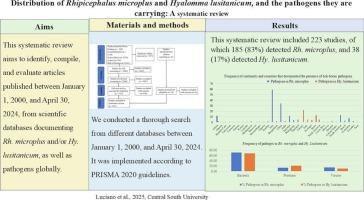微头虫和卢西坦透明瘤的分布及其所携带的病原体:系统综述
IF 2.4
Q3 INFECTIOUS DISEASES
引用次数: 0
摘要
微尖鼻虫和卢西坦透明虫是适应性很强的外寄生虫,以脊椎动物为食,包括人、家畜和野生动物。本系统综述旨在识别、汇编和评估2000年1月1日至2024年4月30日期间发表的相关文章,这些文章来自几个记录Rh分布或流行情况的科学数据库。微加菌和/或lusitanicum,以及全球蜱传病原体。我们从2000年1月1日至2024年4月30日在Embase、Ovid MEDLINE、ScienceDirect、Web of Science和Scopus中进行了全面的检索。该系统评价是根据PRISMA 2020指南实施的。在本系统综述纳入的223项研究中,83.0%检测到Rh。Microplus在42个国家进行了报告。相比之下,17.0%的人检出了lusitanicum,这只在8个国家报告过。本系统综述中共有113项研究报告了蜱传病原体的存在,其中78.8%集中在Rh。微加和21.2%的寻址海西坦。本文报道了94种蜱传病原体。在Rh中发现的蜱传病原体。Microplus中细菌最多,占71.6%,其次是病毒,占15.1%。细菌中以无原体属最多,占26.8%,其次为立克次体,占17.2%。蜱传病原菌以细菌最多,占68.1%,其次是原生动物,占21.3%。细菌中以立克次体最多,占25.5%,其次是无形体,占19.2%。这一系统综述通过整合“同一个健康”方法,为管理和控制蜱传疾病提供了至关重要的见解。本文章由计算机程序翻译,如有差异,请以英文原文为准。

Distribution of Rhipicephalus microplus and Hyalomma lusitanicum, and the pathogens they are carrying: A systematic review
Rhipicephalus microplus and Hyalomma lusitanicum are highly adaptable ectoparasites that feed on vertebrates, including people and both domestic and wild animals. This systematic review aims to identify, compile, and evaluate relevant articles published after January 1, 2000, until April 30, 2024, from several scientific databases documenting the distribution or prevalence of Rh. microplus and/or Hy. lusitanicum, as well as tick-borne pathogens globally. We conducted a thorough search in Embase, Ovid MEDLINE, ScienceDirect, Web of Science, and Scopus from January 1, 2000, to April 30, 2024. This systematic review was implemented according to PRISMA 2020 guidelines. Of the 223 studies included in this systematic review, 83.0 % detected Rh. microplus, reported across 42 countries. In contrast, 17.0 % detected Hy. lusitanicum, which has only been reported in eight countries. A total of 113 studies included in this systematic review reported the presence of tick-borne pathogens, with 78.8 % focused on Rh. microplus and 21.2 % addressing Hy. lusitanicum. In this review, 94 tick-borne pathogens were reported. Of the tick-borne pathogens identified in Rh. microplus, bacteria were the most reported, representing 71.6 %, followed by viruses with 15.1 %. Among bacteria, the genus Anaplasma was the most frequent, with 26.8 %, followed by Rickettsia, with 17.2 %. The tick-borne pathogens identified in Hy. lusitanicum, bacteria were the most frequent, with 68.1 %, followed by protozoa, with 21.3 %. Genus Rickettsia was the most frequent among bacteria, with 25.5 %, followed by Anaplasma with 19.2 %. This systematic review provided insight crucial for managing and controlling tick-borne diseases by integrating the One Health approach.
求助全文
通过发布文献求助,成功后即可免费获取论文全文。
去求助
来源期刊

Parasite Epidemiology and Control
Medicine-Infectious Diseases
CiteScore
5.70
自引率
3.10%
发文量
44
审稿时长
17 weeks
期刊介绍:
Parasite Epidemiology and Control is an Open Access journal. There is an increasing amount of research in the parasitology area that analyses the patterns, causes, and effects of health and disease conditions in defined populations. This epidemiology of parasite infectious diseases is predominantly studied in human populations but also spans other major hosts of parasitic infections and as such this journal will have a broad remit. We will focus on the major areas of epidemiological study including disease etiology, disease surveillance, drug resistance and geographical spread and screening, biomonitoring, and comparisons of treatment effects in clinical trials for both human and other animals. We will also look at the epidemiology and control of vector insects. The journal will also cover the use of geographic information systems (Epi-GIS) for epidemiological surveillance which is a rapidly growing area of research in infectious diseases. Molecular epidemiological approaches are also particularly encouraged.
 求助内容:
求助内容: 应助结果提醒方式:
应助结果提醒方式:


